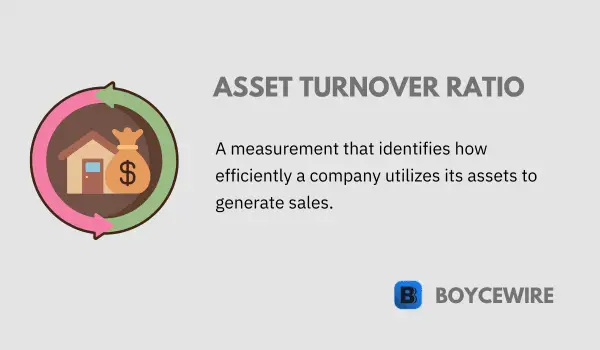Asset Turnover Ratio: Definition, Formula & Examples

What is the Asset Turnover Ratio?
In the financial world, understanding a company’s efficiency in utilizing its assets is crucial for investors, analysts, and the company’s management. One of the key metrics used to measure this efficiency is the Asset Turnover Ratio. This financial ratio gives an insight into how well a company is using its assets to generate revenue. It serves as an indicator of the company’s operational efficiency and can be particularly telling in comparison with competitors within the same industry.
Key Points
- The asset turnover ratio indicates how effectively a company is utilizing its assets to generate sales.
- A higher ratio suggests efficient asset utilization, while a lower ratio indicates potential inefficiencies.
- It is calculated by dividing net sales or revenue by average total assets.
Understanding Asset Turnover Ratio
The Asset Turnover Ratio is a financial metric used to assess the efficiency of a company in utilizing its assets to produce sales or revenue. In other words, it shows how many dollars in revenue a company generates for each dollar invested in assets.
This ratio is particularly important because companies invest heavily in assets – whether physical, such as machinery and buildings, or intangible, such as patents and goodwill – with the primary goal of generating revenue and, ultimately, profit.
A higher ratio is generally better, indicating that the company is more efficient in utilizing its assets. Conversely, a lower ratio might suggest inefficiency, perhaps due to underutilization of assets or the presence of idle or obsolete assets.
However, it’s essential to note that what is considered a “good” or “bad” ratio can vary widely depending on the industry. For instance, industries that are capital intensive like real estate and manufacturing might have a lower ratio compared to service industries or technology companies, which are less asset-heavy.
Therefore, in interpreting the Asset Turnover Ratio, it’s crucial to consider the context, including the nature of the company’s operations, its growth stage, and industry standards. This ratio should not be used in isolation but in conjunction with other financial metrics to gain a holistic view of a company’s financial health.
Calculation of Asset Turnover Ratio
The calculation of the asset turnover ratio is relatively straightforward, and it involves two pieces of information: net sales (or revenue) and average total assets during the period of interest.
The formula can be seen below:
Asset Turnover Ratio = Net Sales / Average Total Assets
Let’s break down each component of this formula:
- Net Sales (Revenue) This is the total income a company generates from its operations. It’s important to use net sales in the calculation, which means sales after returns, allowances, and discounts are subtracted. You can typically find this figure on a company’s income statement.
- Average Total Assets This refers to the average value of assets a company held over a specific period, typically a year. To calculate average total assets, you add the value of total assets at the beginning of the period to the value at the end of the period and then divide by two. The total assets figures can be found on the company’s balance sheet.
Once you have these figures, you divide net sales by the average total assets to get the asset turnover ratio. The result tells you how many times a company turned its assets into sales during the period.
It’s crucial to be consistent with the time periods for both net sales and total assets when calculating this ratio. If you’re looking at net sales for the year, make sure to use the total assets at the start and end of the same year to calculate the average.
Remember that this ratio is typically used to compare companies within the same industry, as different industries have different capital requirements and business models.
Factors Affecting Asset Turnover Ratio
Several factors can influence a company’s asset turnover ratio, which represents how efficiently a company uses its assets to generate sales. These factors can broadly be grouped into operational efficiency, industry norms, investment in assets, and the company’s sales strategy.
- Operational Efficiency The operational efficiency of a company, encompassing production, inventory management, supply chain efficacy, and other related factors, can have a substantial influence on the utilization of assets. Enhanced operational efficiency often results in higher ratios of asset turnover, signifying improved asset utilization.
- Industry Norms Various industries exhibit distinct levels of efficiency in utilizing their resources, resulting in differing ratios of asset turnover. Industries with substantial capital requirements, such as manufacturing or real estate, tend to have lower asset turnover ratios compared to service industries, which can generate sales with fewer assets. Consequently, it is crucial to benchmark a company’s asset turnover ratio against other firms within the same industry for meaningful comparisons.
- Investment in Assets If a company invests heavily in new assets but hasn’t yet fully utilized those assets to generate sales, it may have a lower asset turnover ratio in the short term. However, this might not necessarily be a bad thing if these investments contribute to higher sales in the future.
- Sales Strategy A company’s approach to sales can also influence the efficiency of its asset utilization. For instance, a company that prioritizes high-volume, low-margin sales may exhibit a higher level of asset turnover compared to a company that emphasizes low-volume, high-margin sales.
When analyzing the asset utilization of a company, it is vital to take these factors into account to obtain a holistic view of its performance. A lower ratio does not necessarily signify subpar performance, just as a higher ratio does not always imply superior performance. The context in which the ratio is assessed holds significant importance.
Advantages and Disadvantages of Asset Turnover Ratio
Advantages
- Benchmarking The asset turnover ratio allows stakeholders to compare a company’s efficiency in generating revenue from its assets to that of other companies in the same industry. This helps in evaluating relative performance.
- Efficiency Analysis The ratio provides an effective way to analyze a company’s operational efficiency. A higher ratio suggests that a company is using its assets efficiently to generate sales.
- Investment Decision Investors often use this ratio to decide whether to invest in a company. A company with a high asset turnover ratio may be seen as a better investment because it generates more revenue from its assets.
Disadvantages
- Varying Ratios Across Industries The ratio can vary significantly across different industries due to the different types of assets involved and the nature of business operations. Therefore, it may not be accurate to compare the asset turnover ratio of companies from different industries.
- Quality of Sales The ratio does not provide insight into the profitability of sales or the quality of the assets. A high turnover might be a result of aggressive sales practices that lead to low profit margins.
- Overemphasis on Short-term Performance Prioritizing enhancements in the utilization of assets can potentially result in short-term choices, including reducing asset levels, that may have an impact on long-term growth opportunities.
As with any financial metric, it’s essential to use the ratio in conjunction with other measures and not to rely solely on it to evaluate a company’s financial health or efficiency.
Examples of Asset Turnover Ratio
To illustrate how the asset turnover ratio works, let’s consider two hypothetical companies – Company A and Company B.
- Company A: Company A is a retailer with total assets of $5 million. Over the past year, it reported total sales (revenue) of $20 million. The asset turnover ratio for Company A would be calculated as follows:
Asset Ratio = Total Sales / Total Assets
Asset Ratio = $20 million / $5 million = 4.0
This indicates that for every dollar of assets it owns, Company A generates $4 in sales.
- Company B: Company B is a manufacturing company with total assets of $10 million. Its total sales for the past year were $25 million. The asset turnover ratio for Company B would be:
Asset Ratio = Total Sales / Total Assets
Asset Ratio = $25 million / $10 million = 2.5
This implies that for every dollar in assets, Company B generates $2.5 in sales.
Comparing these two examples, even though Company B made more total sales than Company A, Company A has a higher ratio, indicating it’s more efficient at using its assets to generate revenue. It’s important to note, however, that these ratios can’t be accurately compared across different industries due to differences in business operations and the nature of their assets.
It’s important to note that although the efficiency of asset utilization in generating sales can be gauged through the asset turnover ratio, it does not provide insights into a company’s profitability or the caliber of its assets. To obtain a comprehensive analysis of a company’s financial performance, it is advisable to consider other financial ratios in conjunction with the asset turnover ratio.
FAQs
The asset turnover ratio is a financial metric that measures how efficiently a company uses its assets to generate sales revenue.
The asset turnover ratio is calculated by dividing net sales or revenue by average total assets.
A higher asset turnover ratio suggests that a company is effectively utilizing its assets to generate sales revenue.
A lower asset turnover ratio may indicate potential inefficiencies in asset utilization or declining sales.
About Paul
Paul Boyce is an economics editor with over 10 years experience in the industry. Currently working as a consultant within the financial services sector, Paul is the CEO and chief editor of BoyceWire. He has written publications for FEE, the Mises Institute, and many others.

Further Reading
 Capital Flight: Definition, Causes, Effects & Examples - Capital flight occurs when investors or businesses remove their money from a country.
Capital Flight: Definition, Causes, Effects & Examples - Capital flight occurs when investors or businesses remove their money from a country.  Determinants of Supply - Determinants of supply are the factors that influence the quantity of goods or services that producers are willing and able…
Determinants of Supply - Determinants of supply are the factors that influence the quantity of goods or services that producers are willing and able…  Intrinsic Value - Intrinsic value refers to the underlying or inherent worth of an asset, based on its fundamental characteristics and cash flow…
Intrinsic Value - Intrinsic value refers to the underlying or inherent worth of an asset, based on its fundamental characteristics and cash flow… 
